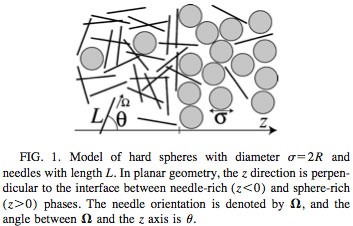| 30. |
Colloidal rod-sphere mixtures: Fluid-fluid interfaces
and Onsager limit J. M. Brader, A. Esztermann, and M. Schmidt, Phys. Rev. E 66, 031401 (2002). Locate in [bare] [illustrated] list. Get [full paper] as pdf. Extract. We investigate the free interface between demixed bulk fluid phases of a colloidal mixture of hard spheres and vanishingly thin needles. Results are presented for the spatial and orientational density distributions of the particles, as well as for the interface tension. Furthermore we generalize the theory to the Onsager limit for interacting rods. [more]  Read the [full paper] as pdf. |
Fluid interfaces
Colloid-polymer mixtures display fluid-fluid interfaces [21] [44], relevant for laser-induced condensation [35], capillary condensation [43] and evaporation [48], immersion in porous media [41], the appearance of the floating liquid phase [52], the competition between sedimentation and phase coexistence [51], tension at a substrate [45], the experimental observation of thermal capillary waves [47], and the contact angle of the liquid-gas interface and a wall [50]. In colloidal rod-sphere mixtures fluid-fluid interfaces were investigated with theory [30] and simulation [42]. Hard sphere fluids were considered at surfaces of porous media [37], in random fiber networks [39], and in one dimensional cases [46].Rod-sphere mixtures
The DFT of [19] was extended to treat rod-rod interactions [30] [49], and used for free fluid interfaces [30] and wetting at a hard wall [40]. Simulations [42] confirmed unusual interfacial rod ordering. See [25] for the demixing phase behavior of the system upon adding polymers.[more]